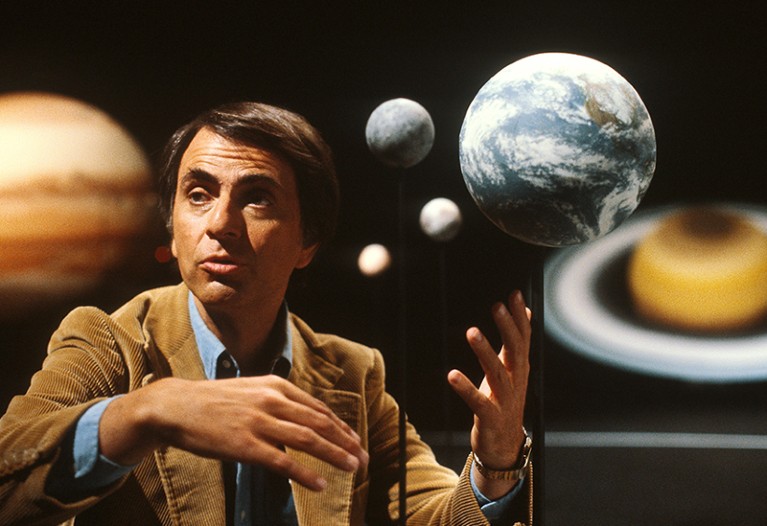Planetary scientist and broadcaster Carl Sagan, who died in 1996, influenced some of NASA’s planetary missions.Credit: Science History Images/Alamy
Early in 1993, a manuscript landed in the Nature offices announcing the results of an unusual — even audacious — experiment. The investigators, led by planetary scientist and broadcaster Carl Sagan, had searched for evidence of life on Earth that could be detected from space. The results, published 30 years ago this week, were “strongly suggestive” that the planet did indeed host life. “These observations constitute a control experiment for the search for extraterrestrial life by modern interplanetary spacecraft,” the team wrote (C. Sagan et al. Nature 365, 715–721; 1993).
The experiment was a master stroke. In 1989, NASA’s Galileo spacecraft had launched on a mission to orbit Jupiter, where it was scheduled to arrive in 1995. Sagan and his colleagues wondered whether Galileo would find definitive evidence of life back home if its instruments could be trained on Earth. They persuaded NASA to do just that as the craft flew past the home planet in 1990.

How would we know whether there is life on Earth? This bold experiment found out
As we describe in an essay, a big concern for the journal’s editors was that the paper did not report a new finding. Nature published it because it was a convincing control experiment to test the accuracy and relevance of the methods being used to detect extraterrestrial life. Had the study found less evidence of life than it did, that would have been even more significant — it would have called into question the relevance of the parameters that scientists proposed as evidence of life on other worlds.
Flying visit
The experiment was possible because Galileo had to loop around Earth and Venus on its way to Jupiter, to get a boost from both planets’ gravity. It passed 960 kilometres from Earth at its closest point, above the Caribbean Sea.
From the spacecraft’s spectrometers, researchers found evidence of oxygen, water vapour, ice and snow, along with carbon dioxide, methane and other greenhouse gases. Its imaging system spotted clouds, oceans, coastlines and rocky surfaces. Although the technology did not have sufficient resolution to be able to detect actual life, it was able to find electro-magnetic signals whose amplitude varied in pulses. These amplitude-modulated (AM) waves were used widely at the time to carry radio and television broadcasts, and were of a type not known to occur naturally. “Of all Galileo science measurements, these signals provide the only indication of intelligent, technological life on Earth,” the team wrote. This was a delicious twist, because Sagan was constantly on radio and television, one of the most recognized science broadcasters of his generation.
The study, now commonly taught, has stood the test of time and contributed to further thinking on frameworks for reporting evidence of life on other planets. Since the early 1990s, astronomers have discovered more than 5,500 planets orbiting stars outside the Solar System. Moreover, a cascade of discoveries is expected in data from NASA’s powerful James Webb Space Telescope (JWST), which is uniquely well equipped to study exoplanet atmospheres.

Replicating scientific results is tough — but essential
Three decades on, Sagan’s classic experiment has three important lessons for researchers and science publishers. The first is that it is important to test not just what we don’t know, but what we think we do know. The second is a reminder to those of us who publish science that control experiments — like replication studies — are as important as research that describes new results.
Last but not least is the lesson implicit in the great care the team took when reporting the findings, including the detection of chemical signatures such as the presence of water or greenhouse gases. It would have been easy, given what was known about life on Earth, to assume that the first piece of evidence clinched the question. Instead, the researchers built up a nuanced conclusion, bringing together all the evidence available to them. Their approach demonstrates why the search for extraterrestrial life will always be one of the hardest problems in science.
